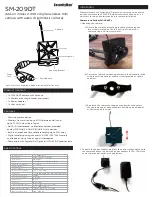
N10316;10/36
- 10 -
●
Recommended timing of asynchronous shutter (/preset shutter) trigger signal (Vinit signal (cc1)) .
●
Recommended timing of asynchronous shutter (/pulse width control) trigger signal (Vinit signal (cc1)).
(Note) The external trigger signal, the pulse width of which is less than 30CLK, are eliminated by filtering.
Input the external trigger signal having the pulse width of more than 31CLK.
If the trigger signal is eliminated, the strobe signal is eliminated at the same time.
(Note)
When the shutter exposure time is too long in the low speed shutter / the pulse width control mode, the S/N ratio of the
image will be degraded due to accumulation of thermal noise components of CCD imaging device in proportion to the
shutter speed and other factors. Therefore, if a long exposure time is employed, it is recommended to conduct experiments
using realistic exposure times in actual conditions to check for the appropriateness.
(Note) When the strobe signal is used in the continuous shutter mode to make ON/OFF control on a lighting source unit, the
following must be taken into consideration:
Wherever possible, use a strobe lighting unit or others that are equipped with a power source separated from that of the
camera (electrically isolated power source) and a trigger input terminal (photo coupler input, etc.). If a lighting unit that
shares a power source or a ground circuit with the camera is turned on or off by the strobe signal, the image output from
the camera may have noise due to the influence of the fluctuation of the power supply voltage or change in the electric
potential that occurs at the ON/OFF timing.
Even when the insulation aforementioned is applied, the electromagnetic induction may lead to the occurrence of noise on
the image signal if the electric current of the lighting unit to be ON/OFF controlled is large. In this case, a measure must be
introduced to reduce electromagnetic induction noise arising from the lighting unit.
●
How to input external synchronous trigger signal
When more than one camera are used in synchronization state, it is necessary to input external synchronous signal (HD/VD
signal) from user side equipment. When it is needed to synchronize horizontal timing, input HD signal.
Input HD and VD signals to synchronize both horizontal and vertical timings.
(Note) Note that the delay jitter may occur between externally supplied HD signal and HD signal within the camera, when
horizontal operation timing is synchronized by external synchronous signal,
(Note) When in asynchronous mode, only the HD signal is effective as an external sync signal. In that case, VD signal is
neglected. Normally, do not apply VD external sync signal in asynchronous shutter mode.
Ex ternal TRI G
Ex pos ure time
SUB
SG
Exposure t ime
:
T1=Electro nic sh utter Preset setting va lue
1CLK = 27.1ns
Filtering
3 0CL K
63CL K
T 1
STRB
30C L K
T 2
T2
米
STRB: Strobe signal
Exposure time
:
T1 '= T1+12 7 CLK
6 3 C L K
T 1
T 1 ’
1 2 7 C L K
T 1
3 0 C L K
Ex ternal TRI G
Ex pos ure time
SUB
SG
ST RB
30 CL K Filte ring
1CLK = 27.1ns
米
STRB: Strobe signal











































